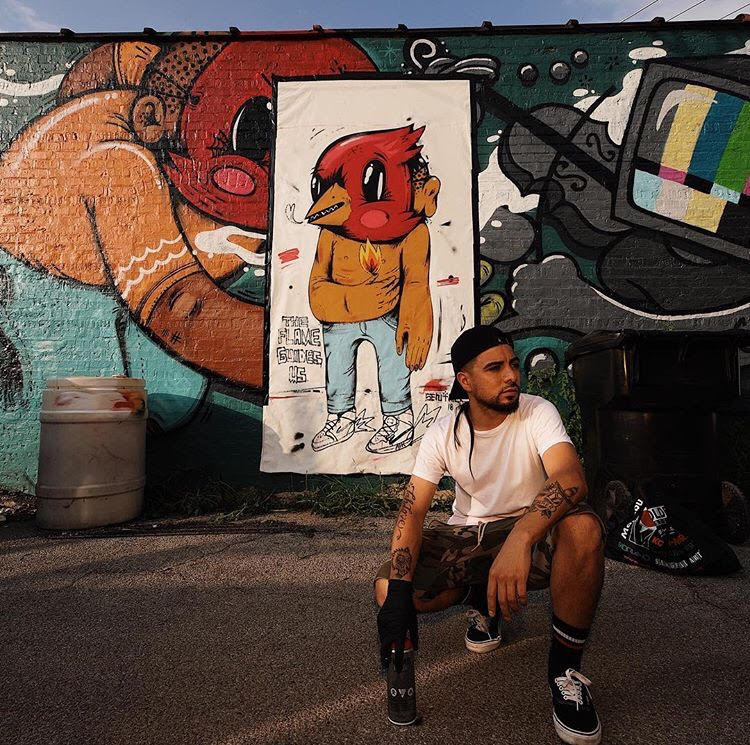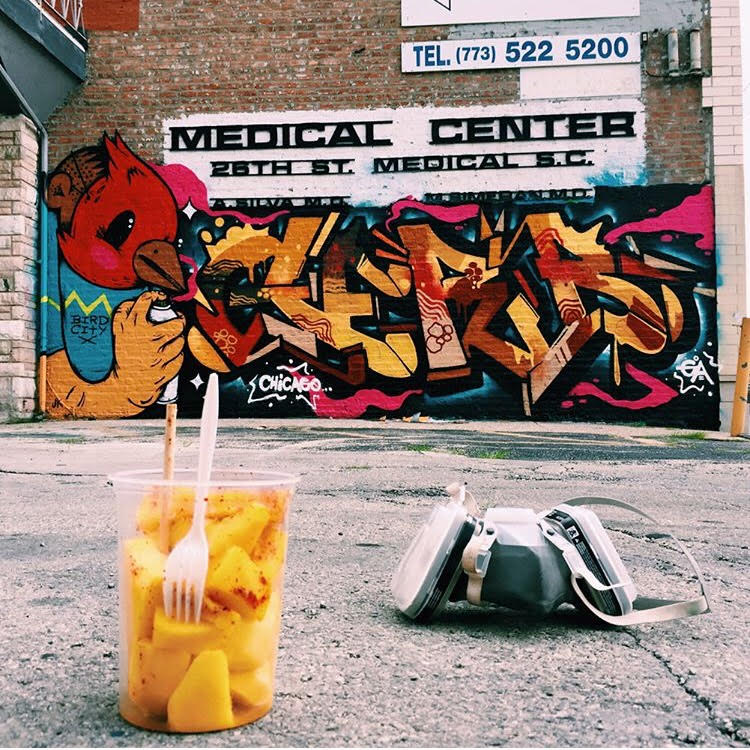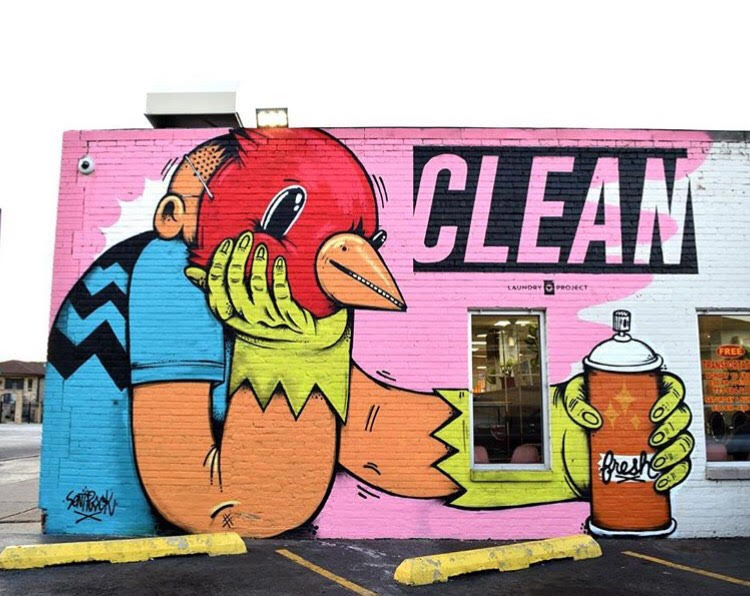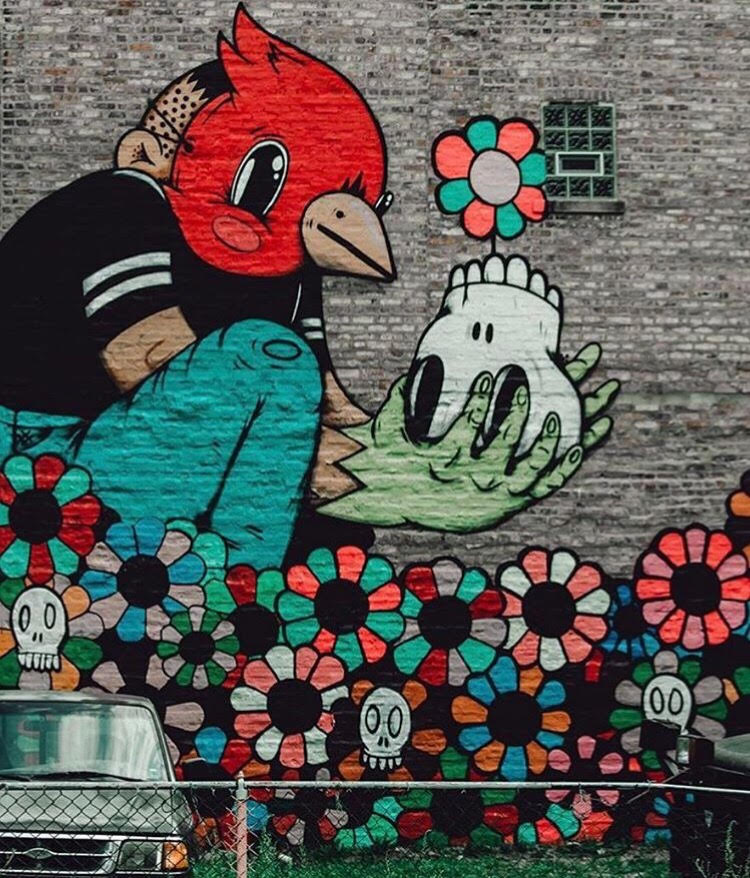You Can Fly Higher: An Interview with Chicago-based Street Artist Sentrock
Sentrock is the moniker of Chicago-based street artist Joseph Perez, who moved to the city from Phoenix, Arizona in 2012. Since then, Chicagoans have likely seen his signature murals of…

Sentrock is the moniker of Chicago-based street artist Joseph Perez, who moved to the city from Phoenix, Arizona in 2012. Since then, Chicagoans have likely seen his signature murals of brown children in red bird masks adorning the walls of buildings all over the North, West, and South Sides. With public art now on display in multiple U.S. cities, Sentrock has still shown the most love for Chicago. His mural across the street from YolloCalli Arts Reach in Little Village in particular has become an important and inspiring fixture that the community members and the young artists who work at YolloCalli have come to admire. Sentrock may not create art to be inherently political, but that doesn’t mean his murals don’t deliver messages. Most of his public pieces contain slogans like “You Can Fly Higher,” “Stay Woke,” and “We Learned To Fly Without Wings” alongside the images of masked young people with black hair and brown skin. In Little Village, a largely Latinx immigrant neighborhood, residents get to see these hopeful messages paired with physical reflections of themselves and their neighbors on several buildings throughout the community.
Like many public artists, Sentrock got his start in graffiti and tagging. But despite Chicago streets being heavily surveilled by a police force trained to view graffiti as vandalism and sometimes even public murals by extension, Sentrock hasn’t had too much trouble with police. I interviewed Sentrock about his approach to mural-making, and the nature of being a public artist in a city where every street tells a different story. This interview has been edited for clarity and length.

Image: Photo of a Sentrock mural of a boy in a red bird mask tagging colorful letters. The mask’s expression is determined and his shirt says “Bird City.” The mural is on the wall of a medical center. A plastic cup full of mango and chile from a street vendor and a gray spray paint mask can be seen on cement in the foreground. Photo by Sentrock.
Anjali Misra: How did you become interested in doing street art and murals?
Sentrock: Just as a kid, I always loved seeing murals and tags. So when I got older, like 14, I got into graffiti art. I just loved the expression, art, trouble-making, and then being able to know I had something I can do and that represented me, no matter how small or meaningless it was to everyone else.
AM: Can you describe your process for deciding what subjects you want to focus on in your art?
S: At first, it was just about me sharing my story or my personal journey. I now, try to give my characters or designs an element that can transcend to all people. I like to reflect my surroundings, my culture, or just what I see at the moment and remain authentic.
AM: Do you see your art as “political”? Why or why not?
S: I don’t see my work at political as in the subject matter , but I am learning my work and what I stand for is political whether I try to be or not.
AM: Why do you think public art is important in the city of Chicago and in Little Village specifically?
S: Well, I would say it’s important for neighborhoods to allow art to reflect the culture and life that creates the community. Public art speaks to all people, from kids walking home to older grandparents to keep their imagination open. Can you imagine living in a place with no art? Like WTF. How do people even create or have identity? Seeing public art makes people think outside the box. Whether people realize or not, it’s giving them permission to think outside the box.

Image: Photo of a Sentrock mural on a laundromat of a brown skinned boy wearing a red bird mask and yellow gloves against a bright pink and white wall. He is holding and looking admiringly at an orange can of spray paint that says “fresh” on it in cursive. The word “Clean” appears next to him, outlined in black and in all caps, above a window. Photo by Sentrock.
AM: What has been the community response to your work in La Villita?
S: Nothing but love, for the most part. I have had many compliments for the murals I’ve done because it’s better than a brown wall or a blank space. I get a lot of love from people my age or younger generations. I do get responses from older generations, however, that just aren’t used to my work. I’ve noticed it’s hard for them to understand it because it’s not something they’ve seen before. I want to be able to be authentic to myself and my community without having to keep my work in a stereotype. Sometimes it’s hard because I don’t get the response I want because my work isn’t the typical iconography or symbols we often see. Nothing against that, but I like to explore my creative options.
AM: It seems that young people are very responsive to seeing your work out in the neighborhood. Do you consider yourself a youth mentor or do you see young people being inspired to become creative as a result of seeing your art out there?
S: Yeah, I would see myself as a mentor to those students that gravitate to my work. I at least try and have an open mind when working with the youth. I try to acknowledge it when I can, I’m not saying all youth are gonna look up to me, but if those that do, I hope to give them motivation. Growing up, I didn’t have too many mentors or people that I could look up to and reach out to them. I literally knew nobody that did art and didn’t see an art gallery or museum until I was already 17-18 years old. I’m just tryna be an example, but as authentic as possible. I’m not the best, or the most famous artist by any means but I hope I can elevate that bar and show em’ if I can do it you can too.

Image: Photo of a Sentrock mural of a brown skinned boy in a red bird mask holding a skull in green gloved hands. A flower grows out of the skull he is holding and he is surrounded by a field of multicolored flowers. Three of the flowers have skulls at their center. A fence and part of a car can be seen in the foreground. Photo by Chris Tejeda.
AM: While community members appreciate public murals, have you had any run-ins with law enforcement? What is the response from city officials in Chicago to street art?
S: As far as that goes, I can’t speak too much on it. At this point in my life I don’t go out and do much illegal work. I’ve been meeting so many business owners and people that own property that now I can work with them, on creating opportunities. I feel street art is an act of doing stuff outside the lines or the norm to push the boundaries and doing work on the streets commissioned or illegal is just an extension of what you want to put out to the world. It’s a lot of layers to that question, but the most important thing is having self-realization and the voice that your art has and what you want to say with it.
AM: What upcoming projects are you most excited about and why?
S: Yes, as of right now, I am always in the works for murals and studio works. I am currently opening a studio in Pilsen. I am hoping to get student interns and open it up for possible workshops. I am really excited about building and growing and exploring what this summer holds for mural projects. I am doing some traveling and group shows in other cities as well, but my focus is building my studio and what I am doing here at the moment.
AM: Anything else you would like to add?
S: Yes, keep in touch any time. Thank you for your time. I am honored 🙂
This article is published as part of Envisioning Justice, a 19-month initiative presented by Illinois Humanities that looks into how Chicagoans and Chicago artists respond to the the impact of incarceration in local communities and how the arts and humanities are used to devise strategies for lessening this impact.
Featured image: Sentrock poses in front of one of his murals of a young person with brown skin wearing a bird mask. He is crouched, wearing a white tee shirt, and holds a dark spray paint can in a black gloved right hand. Photo by Danny Cantu.
 Anjali Misra is a Chicago-based nonprofit professional and freelance writer of media reviews, cultural criticism, and short fiction work. With a background in radio journalism, community theater management, directing and performing, Anjali is passionate about the intersections of art and social change. She earned her bachelor’s in English Lit and a master’s in Gender & Women’s Studies from the University of Wisconsin in Madison, where she had the privilege over the course of nine years to support the work of groups like MEChA, GSAFE, YWCA and Yoni Ki Baat.
Anjali Misra is a Chicago-based nonprofit professional and freelance writer of media reviews, cultural criticism, and short fiction work. With a background in radio journalism, community theater management, directing and performing, Anjali is passionate about the intersections of art and social change. She earned her bachelor’s in English Lit and a master’s in Gender & Women’s Studies from the University of Wisconsin in Madison, where she had the privilege over the course of nine years to support the work of groups like MEChA, GSAFE, YWCA and Yoni Ki Baat.
